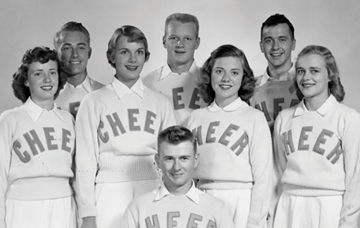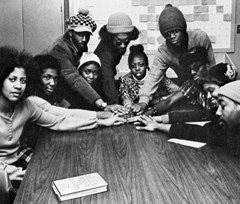Lincoln Hall Project
Illinois at the Crossroads
Shifts in Assumptions

(Courtesy of University Archives)
A Shift Between Eras
The often-overlooked 1950s had their light moments, with giant panty raids (police responded to one in 1953 that involved 1,000 students), the end of a 27-year-old ban on students having automobiles on campus, and a debate over cheerleading that ended in 1950 when the first female cheerleaders proved they could indeed energize a crowd. The decade also had its heavy moments. A biology professor started a nationwide debate—and lost his job—by stating in a newspaper letter that premarital sex between responsible college students was okay. Barbershops were boycotted in 1954 for racism, and legislators hunted for campus communists. One student editorial in 1950 urged legislators to focus on the Korean War rather than investigating “imaginary Communists in Champaign-Urbana.” And it was during the 1950s when the towering elms on the Quad were removed as victims of Dutch Elm disease.
Rewriting Rules for Women
The University of Illinois had long followed the principle of in loco parentis—assuming the role of a parent—when it came to students, particularly women, who abided by rules on everything from sunbathing to dating behavior and obtaining parental permission for overnight trips. Students rebelled increasingly against such measures, with one controversial column in the Daily Illini in 1964 reading, “A 21-year-old University senior, supposedly highly educated, capable of deep understanding, and legally allowed to drink and vote, has restrictions placed on her that an 18-year-old high school dropout wouldn’t have to put up with.”

(Copyright Illini Media / 1973 Illio)
Fight for Racial Equality
By 1967 only 372 black undergraduates attended the University of Illinois, out of 30,400. One historian notes that black students felt so excluded from the campus mainstream that they referred to the former University mascot as a “malicious” force, describing the academic failure of a peer by saying, “The Chief got him. He won’t be coming back.” In 1968, following the death of Martin Luther King Jr., more than 500 black and Latino students were admitted as part of Project 500.